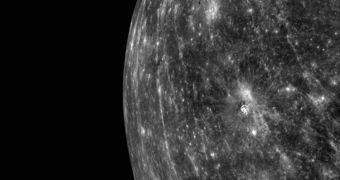Ever since the MESSENGER space probe reached the innermost planet in our solar system, earlier this year, researchers have been puzzled by hollows the spacecraft detected on the planet's surface. Experts now propose new ideas to explain the formation.
The NASA mission's full name is the MErcury Surface, Space ENvironment, GEochemistry and Ranging spacecraft. Its goal is to analyze a multitude of aspects related to the planet's surface, atmosphere and interior structure.
When it first began studying the planet, the probe began to observe weird hollows on the surface that it could not explain. Researchers have been scratching their heads over the images, since there are no known structures on Earth that resemble these formations.
A planetary geologist is now proposing that the hollows are in fact caused by hydrogen gas venting out of Mercury's interior. One of the things that made the scientist believe this is the case is that the structures are located mostly inside impact craters.
This means that they are relatively new additions to the planetary surface, no more than a few hundreds of millions of years old. The exact reason why they appear to have a propensity for crater floors represents yet another mystery, Technology Review reports.
According to MESSENGER data, the features are irregularly-shaped, shallow and rimless, attributes that are inconsistent with those of any other geological feature scientists are familiar with. To make matters even more complex, these locations are very bright.
What this implies is that they are covered in a layer of highly-reflective material. Furthermore, these discoveries indicate that the Mercurial core is active to some extent. However, previous studies have certified that the planet's core is no longer turning underneath the crust.
Now, San Diego, California-based independent scientist Marvin Herndon believes that the once-liquid planetary core may have absorbed vast amounts of hydrogen before it began solidifying. That hydrogen may now be trying to escape to the surface through points of minimal resistance.
This may explain why the features mostly develop at the bottom of crater floors. The researcher even proposes that large hydrogen geysers develop on the surface of Mercury at regular intervals.
What is interesting in the new proposal is the fact that Herndon proposes an interesting new process as well. He explains that the hydrogen moving towards the planetary surface may be reacting with other chemicals stored beneath the surface, such as iron sulphide.
This creates metallic iron particles, which the expert proposes as being responsible for making the depressions so reflective when viewed from orbit.

 14 DAY TRIAL //
14 DAY TRIAL //